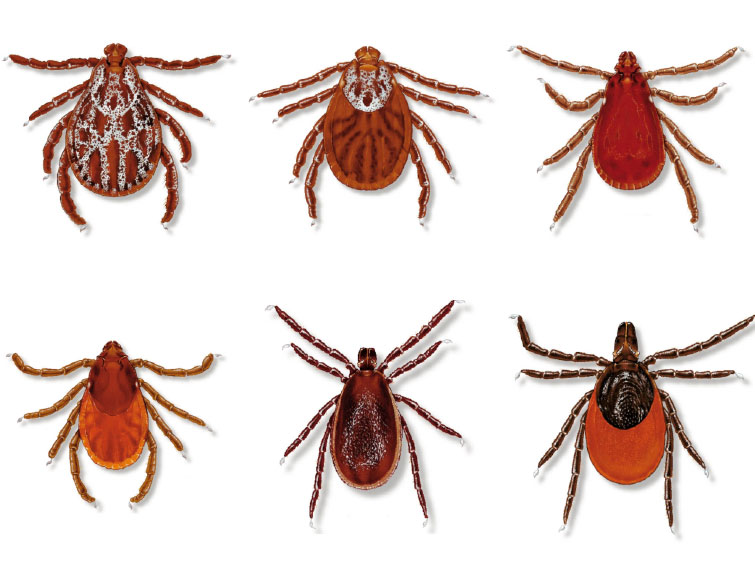6 Tick-Borne Diseases to Keep At Bay
Ticks flourish throughout South Africa. They may be tiny but they carry dangerous bacteria or viruses that can lead to tick-borne diseases. Find out more in this article!
TICKS

Posted by bravectosouthafrica – 02 April 2020
Ticks may be small, but they can cause life-threatening diseases. That’s why you need to take these tiny threats seriously. Many of these disease are tick borne diseases, what is a tick borne disease? As part of the arachnid family, a tick has eight legs and a raisin-like body that plumps up to an egg-shape after it is full after a meal. In a tick’s view, a healthy helping of blood is delicious. Yes, it’s true, these external parasites feed off of reptiles, birds, amphibians, and mammals – that means you, your family and your beloved dogs or cats could be next. Gasp!
Unfortunately, some of these tiny blood-suckers don’t just attach themselves to their hosts and drop off once they’ve had their fill. Some ticks are vectors for dangerous diseases that could prove fatal. Take care to avoid ticks where they thrive, like woody, bushy, coastal or rural areas and take special precautions to ensure they don’t hitch a ride home.
The tick family is well-established with hundreds of different species on every continent. The good news is that in South Africa there are only a few tick-borne diseases you need to worry about. Know these diseases, the ticks that carry them, and their remedies and you’ll be geared to conquer whichever tick crosses your path.

6 Most Common Tick-Borne Diseases & Maladies in South Africa
Wherever you go, from up in Africa to Europe, the Americas, Asia and beyond, one or more species of tick is bound to call the area home. So, if you plan on travelling, read up on your destination’s common pest-borne diseases to ensure that you can prepare appropriately.
In South Africa, at least with this guide, you’ll know which tick-borne diseases to be wary of. Illness can result from viruses, bacteria or protozoa that a tick carries. Up to twenty species of ixodid ticks (aka hard-shell ticks) feed on humans. Fortunately, not all of these are vectors of life-threatening illnesses. Read on for the most common tick diseases in South Africa.

1. Babesiosis (Babesia rossi)
Babesiosis, also known as tick fever or biliary fever, is a malaria-like parasitic condition that dissolves blood cells which leads to haemolytic anaemia; destruction of red blood cells faster than their production rate. Red blood cells are vital as they transport oxygen to every organ in your body; without them, the body will malfunction.
The Babesia parasite can affect a range of mammals, the most common being cattle, sheep, pigs, goats, dogs and horses. Human babesiosis is extremely rare in South Africa, with only two cases reported by Bush et al. in 1990. This form of babesiosis is caused by the Babesia microti or Babesia divergens in immuno-compromised individuals, like the elderly.
Symptoms of Babesiosis
- Fever
- Lethargy
- Swollen lymph nodes
- Unkempt coat (cats and dogs)
- Lability and confusion
- Toxic shock
- Dizziness and collapse
- Weakness
- Muscle pain and headache
- Anorexia (lack of appetite)
- Jaundice
- Dark-coloured urine
- Pink eye
- Abdominal pain
- Nausea and vomiting
Babesiosis Treatment
Treating babesiosis relies on anti-parasitic drugs, similar to those used in malaria. Mild cases require medication for 7-10 days. However, a severe infection will require intravenous as well as oral administration of medication. In some of the most virulent cases, blood transfusions may be necessary. Similar to malaria, relapse is possible after recovery and treatment of secondary symptoms are vital.
Tick Vectors
The South African yellow dog tick (Haemaphysalis elliptica) is responsible for most babesiosis infections in South Africa, as it is a common tick found on domestic plots, small-holdings and farms.
Risk Areas
The South African yellow dog tick prefers bushy areas. They thrive after rainfall in warmer regions from East London through to the Zimbabwean border, Mpumalanga, Limpopo, Free State, Gauteng, North West Province, Eastern and Western Cape areas

2. Ehrlichiosis
Ehrlichiosis, also known as heartwater or tropical canine pancytopaenia, is a bacteria-based tick disease that resembles flu in its symptoms. However, if left untreated, symptoms become more severe and may result in brain damage or even death. Those with weakened immune systems are most at risk of contracting the illness from a tick vector.
Symptoms of Ehrlichiosis
- Fever
- Chills
- Muscle aches
- Loss of appetite
- Nausea and vomiting
- Diarrhoea
- Skin rash
- Confusion
- Respiratory failure
- Organ failure
- Uncontrolled bleeding
- Nervous system or brain damage
Ehrlichiosis Treatment
Early treatment of ehrlichiosis is vital to recovery and, in some instances, survival. Effective treatment in antibiotic form can only be administered by a doctor to prevent death or severe complications. If you suspect an infection, don’t delay seeing a trained medical professional.
Tick Vectors
The kennel tick (Rhipicephalus sanguineus), a reddish-brown or yellowish insect with a smooth body is responsible for transmitting the bacteria responsible for canine ehrlichiosis.
Risk Areas
The kennel tick is prevalent nationwide, but it prefers warm and moist regions, although it can survive dry areas. As a common, adaptable tick it often infests kennels and houses in semi-rural areas.

3. Tick Bite Fever
Tick bite fever, (TBF), is a bacterial infection that occurs in urban areas as well as the outskirts of a city and affects humans only. The illness is not always severe but it can cause virulent or fatal complications. TBF is often confused with African Tick Bite Fever (ATBF), which has milder symptoms and usually occurs in rural settings in infected game and cattle. Both fevers are classified as a common spotted fever. However, TBF is most common in South Africa.
Symptoms of Ehrlichiosis
- Nightmares
- Malaise
- Fever
- Headache
- Muscle pain
- Skin rash (small raised red marks)
- Enlarged lymph nodes
- Black bite mark (resembles an ulcer)
Tick Bite Fever Treatment
Antibiotics may be administered, depending on the severity of the infection, to limit the chance of a host developing side-effects.
Tick Vectors
In one bite, Kennel ticks can transmit the bacteria that leads to TBF. However, these ticks will wait passively until a host strolls past for them to latch on. The Bont tick, which can also cause TBF and other tick-borne diseases, actively seeks out a host.
Risk Areas
Bont ticks flourish in bushy, moisture-rich warm climates, especially in the coastal regions of South Africa. If you can’t avoid these areas, take special precautions and check yourself for ticks if you do head into riskier environments on a hike or camping trip. The kennel tick can survive in most areas of the country, often near urban regions. However, they will hitch a ride on your pet instead of humans or cattle. So, check your pets for ticks regularly to avoid infection.

4. Crimean-Congo Haemorrhagic Fever
Unlike many tick-borne diseases, Crimean-Congo Haemorrhagic Fever (CCHF) is specific to human hosts and can be deadly, with as many as 40% of cases proving fatal. The onset of symptoms is sudden as the progression of the virus is swift. This tick disease is caused by the Nairovirus, which is zoonotic and can spread from tick to animal to human. South Africa is not a hotspot for the virus; however, recent cases have been reported.
Symptoms of Crimean-Congo Haemorrhagic Fever
- Light sensitivity and sore eyes
- Sore throat
- Lability
- Confusion
- Lethargy
- Insomnia
- Depression
- Fatigue
- Sudden fever
- Tachycardia
- Petechial rash which may result in other haemorrhagic phenomena
- Kidney failure
- Stiffness
- Sleepiness
Crimean-Congo Haemorrhagic Fever Treatment
Sadly, there is no vaccine for CCHF. Supportive treatment ease the symptoms and side-effects of the virus. If patients do recover, their improvement becomes evident by the tenth day.
Tick Vectors
Ticks of the Hyalomma genus are most likely to transmit the CCHF causing virus to mammal hosts, but many other tick species can carry the virus as well. But the transmission is not limited to ticks. Coming into contact with infected blood of an animal, either during or immediately after it leaves a body (e.g. at a slaughterhouse), could lead to infection. Human-to-human transmission is possible through coming into contact with infected organs, blood or other bodily fluids.
Risk Areas
People at risk of the tick disease are who those working with livestock, like workers in a slaughterhouse or veterinarians, healthcare workers and travellers in endemic areas.

5. Feline Haemobartonellosis
Feline Haemobartonellosis, also known as feline infectious anaemia, is a tick disease caused by a mycoplasma bacteria that lives on the membrane of a cat’s red blood cells. Once the mycoplasma attaches to the cells, it damages the membrane which can lead to cell death and anaemia. Destruction of red blood cells may also be the result of the cat’s immune system trying to rid itself of the latched bacteria.
Symptoms of Feline Haemobartonellosis
- Pale gums
- Reduced appetite
- Jaundice
- Enlarged spleen
- Depression
- Weakness
- Pallor
- Rapid and heavy breathing
- Increased heart rate
Feline Haemobartonellosis Treatment
Antibiotics are used to treat infected cats. Cats receiving treatment may have difficulty breathing as a side effect and may require an increased intake of liquid. In severe cases, or when cats are not responding to antibiotics, corticosteroids or blood transfusions are administered to limit the destruction of red blood cells.
Tick Vectors
Various tick species and other blood-sucking insects, like fleas and mosquitoes, can carry the M. haemofelis bacteria. However, the transmission is fluid and not limited to a vector agent.
Risk Areas
Risk is not limited to one area as inter-cat infection can easily occur and transmission doesn’t rely on vectors, like ticks, alone.

6. Additional Tick-Borne Diseases
Not only can ticks cause life-threatening disease, the bacteria or virus they carry can also lead to terrible side effects. If ever, you experience strange symptoms or notice something on your pet, seek medical help as soon as possible.
The small smooth bont-legged tick (Hyalomma truncatum) can cause skin necrosis. Skin death occurs in their typical hosts, like cattle. They thrive throughout South Africa. This tick can also carry CCHF and cause lameness in its hosts.
Another tick that can cause lameness and, in severe cases, paralysis, is the Karoo paralysis tick (Ixodes rubicundus). Even though their hosts are often larger agricultural animals, pets can also fall victim to their bite. These ticks prefer the cool climate of rugged veld and hills in the Karoo, Free State, Mpumalanga and Gauteng.

Avoid Tick Diseases with Bravecto® Protection
Wherever you go, prevention is the best way of dealing with ticks and other parasitic insects. Wear protective clothing in high-risk areas and ensure that your pets are up to date on their tick, flea and mite treatments.
Bravecto® Chews for Dogs is a tasty treat that protects your pet for 12 weeks, while the Bravecto® Spot-On for Dogs effectively protects your dog from ticks for 4 months and fleas for 6 months. Bravecto® Spot-On for Cats keeps kitty safe from ticks, fleas and ear mites for up to 3 months!
Learn more about Bravecto® products or find a stockist near you and protect your pets today!
Subscribe to our Newsletter
Get to know your furry friend better! Sign up for all things dog- or cat-related.
The Hairy Facts about the dreaded hairball
12 April 2021
Help! My dog’s barking mad! Volume 2
12 April 2021
Your Itchy, Scratchy Cat – All About Cat Skin Problems
12 April 2021
The Dog’s Diet: A Bone of contention?
01 April 2021
Mango Fly Worms: How to Spot and Eliminate them
Posted on November 28,2019
Managing Mange And Mites In Your Dog
Posted on June 11,2018
Why Do Cats Purr and How? Learn What Your Cat Is Saying
Posted on October 14,2020
How to Get Rid of Ear Mites in Dogs
Posted on November 06,2019









